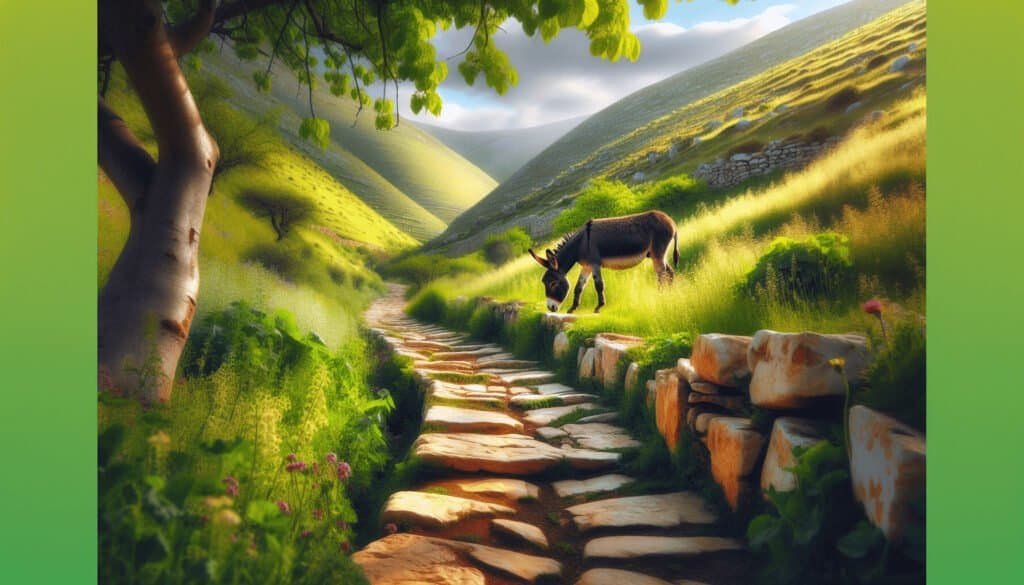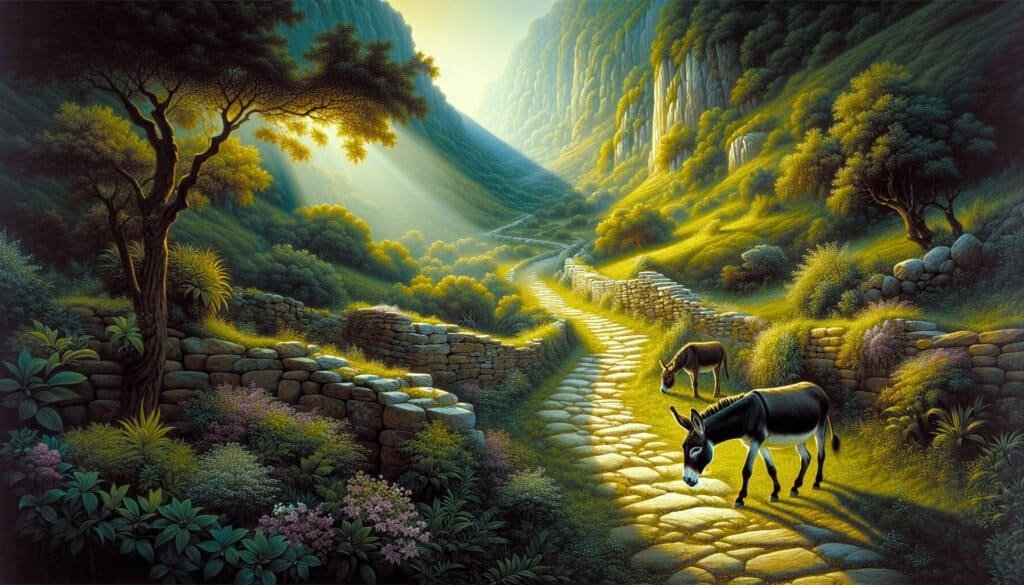What stories do the winds whisper through ancient paths? As you stroll along the Stray Donkey Path, a trail etched into the history of human pilgrimage and cultural journeys, you’re not just walking on dirt and stones. You’re following footsteps of those who sought solace, sanctuary, or perhaps just a bit of adventure under the sun. Let’s unpack the layers of history and significance wrapped around this fascinating path and discover the cultural narratives it carries.

Understanding the Stray Donkey Path
The Stray Donkey Path is not merely a path; it’s a vessel of ancient stories, a corridor that echoes the lives of pilgrims who traveled through shifting sands to reach sacred places. It connects various cultures and traditions, serving as a reminder of the resilience and determination of those who walked it. Each stone and footprint holds a tale that deserves to be told.
A Brief Historical Background
While the specifics of the Stray Donkey Path may vary based on who you ask—historians or local storytellers—its importance is a given. The path has historical roots that trace back to ancient trade routes, traveling merchants, and spiritual seekers.
Trade Routes: It served as a vital artery for merchants, connecting local economies and allowing cultural exchange. Imagine the hustle and bustle; spices and silks changing hands, creating a tapestry of interaction between diverse communities.
Pilgrimage: Over centuries, the path became a pilgrimage trail. People seeking spiritual enlightenment would traverse its winding ways, perhaps inspired by stories from religious texts that beckoned them toward distant horizons.
The Cultural Tapestry
You might wonder what makes the Stray Donkey Path culturally significant. It weaves together multiple narratives that make up the collective memory of a civilization. Through the lens of art, literature, and spirituality, the path finds its place in the fabric of culture.
Artistic Expressions: Many artists have drawn inspiration from the scenery along the path. Paintings and poetry reflect its beauty and mystique, capturing the essence of the journeys undertaken.
Literary References: The path finds itself in ancient texts, with references that could bring any bibliophile to life. It becomes a character within stories, symbolizing both struggle and hope.
Pilgrims on the Path: A Closer Look
When you think about the individuals who have traversed the Stray Donkey Path, a plethora of personalities comes to mind. Pilgrims, traders, and even outlaws have left their mark, contributing to its rich history.
The Pilgrim’s Journey
For many pilgrims, the journey along the Stray Donkey Path is both physical and spiritual. It’s not just about reaching the destination but rather about the trials and transformative experiences along the way.
Spiritual Practices: Pilgrims often engage in rituals or prayers at specified points along the path. These moments serve as markers in their journey, allowing for reflection and connection with the divine.
Community and Connection: Pilgrimage is a shared experience. Along the path, travelers often form bonds that transcend cultural and linguistic barriers. It’s a beautiful manifestation of humanity’s shared quest for meaning.
Merchants and Traders
The path also thrived thanks to merchants. Picture bustling markets along the route, where vibrant conversations happen amidst the exchange of goods.
Goods and Services: Items from across the region would make their way along the path. Think about how spices, textiles, and even ideas were shared among merchants, fostering a rich exchange of not just material goods but also cultural insights.
Cultural Exchange: Interactions between merchants from diverse backgrounds led to the blending of languages, culinary practices, and crafts, enriching everyone involved.
The Outlaws and Rogues
Not every story is painted with light. The Stray Donkey Path also bore witness to the darker side of humanity, with tales of those who wandered off the beaten path—literally and figuratively.
Legends of Bandits: To some, it was an escape route. Tales of bandits and misfits make the path all the more intriguing. The duality of the journey reflects human nature; sometimes, the road less traveled leads to unsavory encounters.
Paradox of Danger and Adventure: The thrill of the unknown beckons many. For some, the danger present along the path was part of the adventure—the ultimate test of courage.
Archaeological Findings and Insights
To truly appreciate the significance of the Stray Donkey Path, it’s worth delving into archaeological findings that have unraveled its history. These excavations breathe life into what might have otherwise been mere legend.
Artefacts Unearthed
What’s remarkable about archaeology is its ability to give us tangible pieces of the past. Each item uncovered tells a story, connecting us with those who walked the same earth.
Pottery and Tools: From simple pottery shards to complex tools, each artefact provides insight into daily life along the path. How did they eat? What crafts did they prioritize? The items tell of resilience amid adversity.
Religious Relics: Certain findings highlight the spiritual aspect of pilgrimage. Objects related to worship, such as incense burners or small statues, serve as a testament to the faith that propelled many on this journey.
Historical Records
Historical texts corroborate many of the narratives gleaned from artefacts. You may find it fascinating how records from different civilizations overlay with the findings from excavations.
Travel Diaries: Ancient travelogues recount experiences along the Stray Donkey Path. These documents reflect the sentiments of those who traversed it, providing rich descriptions that bring you closer to their experiences.
Scriptural References: Some religious texts reference routes akin to the Stray Donkey Path, drawing intriguing parallels that underscore its spiritual significance.
Interpretation and Perspectives
The interpretation of archaeological findings and historical texts can vary widely. It’s crucial to approach them with an open mind, recognizing that each narrative is shaped by its context.
Scholarly Research: Archaeologists and historians continuously engage in research, seeking to unveil fresh insights. As you read their analyses, consider how they connect dots from the past to the present.
Community Input: Local narratives often add depth to scholarly interpretations. Engaging with stories told by community members can provide a more nuanced understanding of the path’s cultural context.
Theological Significance
The Stray Donkey Path holds profound theological significance, particularly in the realms of spirituality and faith. For many, it serves as a metaphor for the journey of life, a pilgrimage not just of the body but of the soul.
Symbolic Representation of Journeys
When you think of the path, consider how its twists and turns might reflect your own journey in life. The metaphor extends beyond just a physical path; it represents challenges faced and lessons learned.
Life’s Many Paths: Just as pilgrims navigate the twists of the Stray Donkey Path, you too navigate the winding roads of life. The trials along the journey can often lead to the most profound growth.
Personal Reflection: For those who undertake a pilgrimage, the path is a space for reflection. Contemplation of one’s life choices and spiritual beliefs finds its place amidst the serenity of nature.
Connecting with Tradition
The act of pilgrimage connects individuals to their ancestors and spiritual traditions. Whether you walk the path or simply hear its stories, you can feel a connection to those who’ve walked before you.
Ancestral Bonds: Pilgrimage ties you to generations of seekers who have traveled the same route. You can sense the weight of their experiences—an unbroken line of yearning and discovery throughout history.
Spiritual Rituals: Many pilgrims engage in rituals unique to their faith traditions, providing continuity and a sense of belonging. The path becomes not just a physical journey but a spiritual odyssey.

Modern Interpretations and Relevance
In today’s fast-paced world, the Stray Donkey Path remains relevant. It’s not just a relic of history but a living testament to the enduring human spirit.
Contemporary Pilgrimage
You might notice a resurgence in interest in pilgrimage among modern seekers. Many individuals now pursue paths for spiritual growth and personal discovery.
Wellness and Reflection: In an age of technology and constant distraction, walking the Stray Donkey Path becomes a statement of intent—an invitation to slow down and engage in self-reflection.
Community Experience: Groups often take pilgrimages together, fostering a sense of community. The shared experience along the path strengthens bonds and builds new friendships.
Cultural Revivals
The stories of the Stray Donkey Path are being revived in contemporary culture. You may find that artists, writers, and filmmakers draw from this rich history, weaving it into modern narratives.
Artistic Representations: You might encounter art installations or literature inspired by the path’s beauty, bringing its history into current conversations and artistic expressions.
Interdisciplinary Studies: Scholars from various fields are exploring the path’s significance from diverse angles. This interconnectedness highlights the cultural and spiritual relevance that transcends academic boundaries.
Conclusion: Tying Past and Present
As you traverse the Stray Donkey Path—whether literally or through the stories shared here—you are participating in a timeless journey that encapsulates the essence of human experiences. This ancient trail, steeped in history, serves as a metaphorical bridge connecting past sages with modern seekers.
As we discussed, the path is a canvas of cultural significance, showcasing the interplay of commerce, spirituality, and community throughout centuries. Understanding its stories not only enriches our knowledge but reinforces the bonds of humanity that persist through time.
In this journey, you see that every path has the potential to shape our understanding of ourselves and the world. With each step you take, you continue the age-old tradition of seeking, learning, and discovering—finding your own connection to the narratives that script our shared existence.


